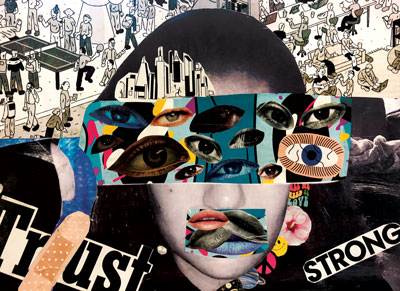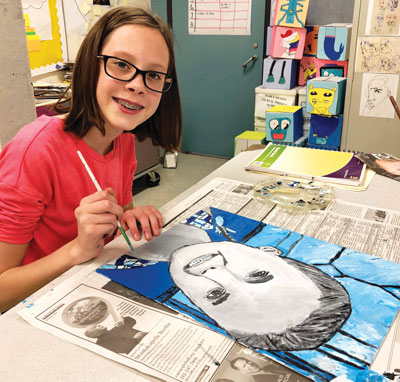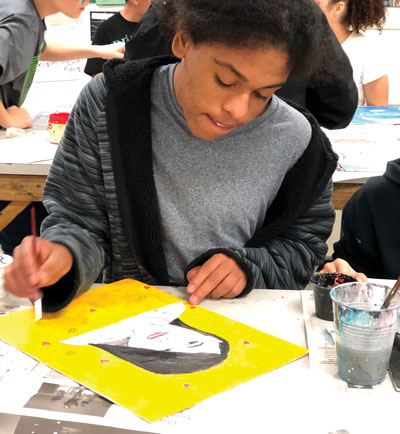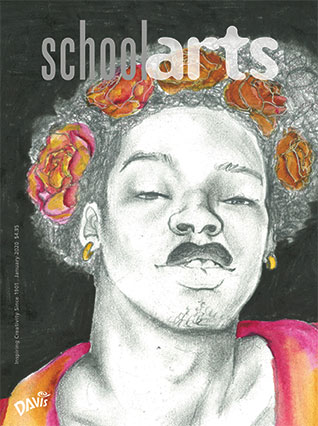 |
 |
| Top: Claire, collaged portrait. Bottom: Ella paints a portrait. |
Encouraging Empathy Encouraging students to be empathetic can be a challenge because it requires a level of personal exposure. Empathy necessitates vulnerability—vulnerability at a time when the opinions of your peers matter more than most other things is a scary challenge for anyone, let alone a middle-school student. To build sincere emotional connections to the feelings of others, students have to tap into their own—they have to risk being seen.
As art teachers, we ask students to participate in new activities they may have no experience with; to discuss challenging and controversial topics; to contribute to their artistic process in a meaningful way. We want them to share about themselves, but they are appropriately unsure of who they are. It is not enough to treat empathy as an art project; we need to extend the power of empathy and vulnerability as practices that are woven into the core of our creative time together. So how can the middle-school art class be a fertile place for these goals to grow? Here are some ideas:
Create Spaces for Risk-Taking
Students want to feel like they belong in the artroom. When they associate success in art with becoming adept at a technical skill, they can miss an opportunity to open up. It’s especially easy for middle-school students to get discouraged by such thinking. Getting students to collaborate in discussion and art-making activities that emphasize process over product and connect students to their outside world is crucial.
These spaces can establish an environment where students take more risks and bring more meaning to their practice. Having students explore a wide range of artistic methodologies and expressions can open their eyes and hearts to trying new things. Here are three ideas for inspiring this:
1. Community Building
Devote a day every week to community building through learning about artists who share their personal stories through their art. At my middle school, we created a routine called, “Wait… What?! Friday!” Each Friday, students explore a new artist or series of artists working around a similar theme. We usually have an inspired activity and discussion to expand traditional concepts of what art can be about.
While general class expectations remain, these days are built for exploration and community building. Without the weight of a grade attached or the pressure of committing to a longer project, I find students can be a little more courageous with their approach to making art and opening up about ideas. Selecting artists who are sharing their own stories and making themselves vulnerable can be a great way for students to build skills in understanding the perspective of others.
2. Use Sketchbooks Purposefully
Use sketchbooks as a tool for building empathy. Have students reflect on their emotional responses to artworks and identify how certain processes or images make them feel. Have students collect quotes, images, and ideas from artists and peers. Drawing is a type of listening. Try to get students to slow down and observe their world. Make the sketchbook a place where students can share about themselves and have space to warm up or retreat to.
 |
| Dasawn paints a portrait. |
3. Teach with Art That Shares Stories
Stories build compassion, help our students consider the feelings of others, and can inspire meaningful emotional responses. Focus on artists who are making work that engages their own communities.
Use these artists as a catalyst for students to interact with their own histories and communities. Sometimes an indirect approach can inspire an easier space for vulnerability and connection to grow. Here is a project I did with students last year with this in mind: I asked students, “How do artists make portraits to build a more compassionate world?” Students learned about various artists using portraiture to represent a community significant to them. We deconstructed a range of different portraits, listened to oral histories, and watched videos in which artists talk about their work.
This research provided a rich framework for students to share stories themselves and select people in their community to interview, photograph, and paint. Through the process, students inadvertently shared personal stories of love, loss, and admiration. The best part was that these conversations happened organically. The spotlight was not on them, so they felt more comfortable sharing.
Artists researched for this portrait investigation included Jordan Casteel, Brendan Stanton, JR, Gordon Parks, Alice Neel, and Catherine Opie. We read quotes from Chimamanda Ngozi Adichie’s TED Talk about stories and stereotypes and watched animated stories recorded through StoryCorps.
Conclusions
Establishing a safe and creative space for empathy calls for us to be open and vulnerable, too. We have to be ethical and helpful in our approach. We have to model behavior we want our students to be inspired by, and we need to respect that their journey may take time and mistakes. We have to try lessons and ideas that we are unsure of and embrace the idea that uncertainty can lead to greatness.
Danielle McDonald is an art teacher at Nyack Middle School in Nyack, New York. DMcDonald@NyackSchools.org
WEB LINK
Integrating Empathy: brenebrown.com/classroom-integration-ideas/
View this article in the digital edition.





